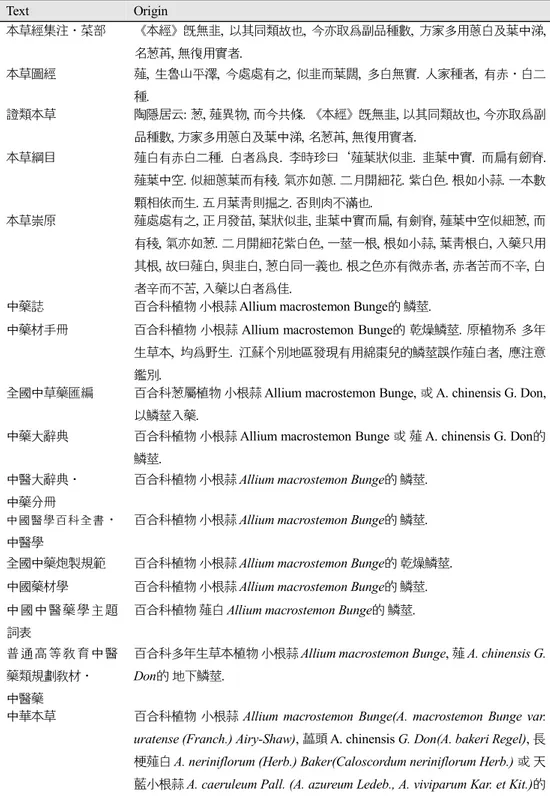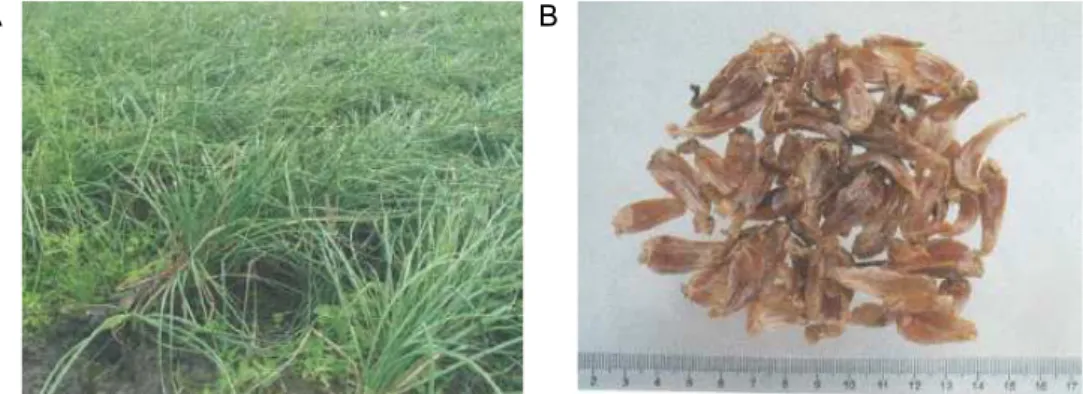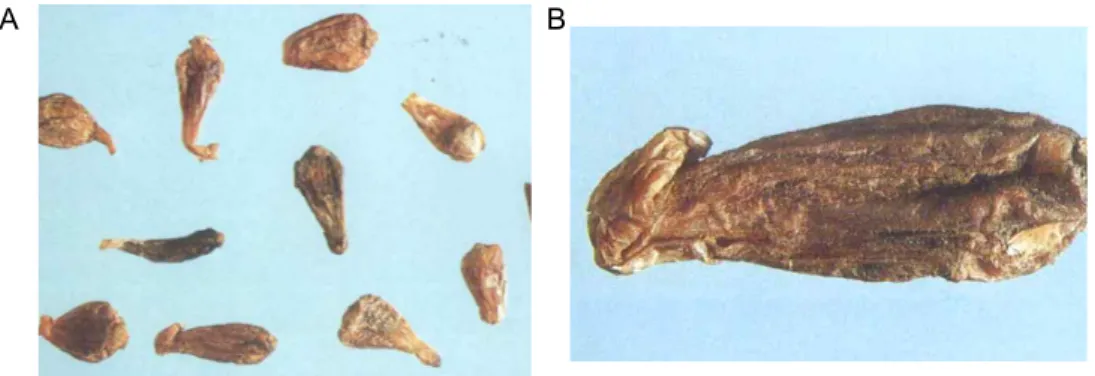薤白의 기원에 관한 문헌적 고찰
정종길#*
동신대학교 한의과대학 본초학교실 1)
* Corresponding author : Jong-gil Jeong, Department of Oriental Medicine Prescription, College of Oriental Medicine, Dong-Shin University, DongShindaegil 67, Naju, 58242, South Korea.
E-mail :
jgj3523@naver.com
· Received : 2020/12/08 · Revised · 2020/12/27 · Accepted : 2020/12/30
Bibliographic Study on the origin of Allii Macrostemi Bulbus
Jong-gil Jeong#*
Dept. of Herbology, College of Oriental Medicine, Dong-Shin University.
Objective: The aim of this study was to analyze the origin and characteristics of Allii
Macrostemi Bulbus.
Methods: Bibliographies on Allii Macrostemi Bulbus that focused on the origin of the material
were examined. Based on this analysis, an inventory was prepared and the characteristics of the original material are presented.
Results: Korean and foreign literature were reviewed to prepare an inventory, and Based on
these results, the state of plants either currently cultivated or distributed as medicines, , and are summarized.
1. The origin of Allii Macrostemi Bulbusis the scaly stem of Allii macrozoon Bunge or Allii bakeri Regel.
2. The current white water mark in circulation is the scaly stem of the sandalae Allii macromoleon Bunge.
3. Scilla sinensis(Lour.) Merr. is .
4. The properties of Scilla sinensis(Lour.) Merr. are cool and bitter, healing the forests, mowing the ointment, stopping the oxen, and curing the absence of distractions and stuffy symptoms and removal of the placenta after childbirth.
Conclusions: The origin of Allii Macrostemi Bulbusis the scaly stem of Allii macrozoon Bunge
or Allii bakeri Regel.
Keywords: Allium macrostemon, Allium chinense, Allium bakeri, Bulbus, Scilla sinensis
서 론
《藥徵》에서 薤白은 主治心胸痛. 而 喘息咳唾也. 旁治背痛. 心中痛.
1)이라 하 였으며, 同 서적의 「考徵」 항목에서는 括蔞薤白白酒湯證曰. 喘息咳唾. 胸背痛. 枳 實薤白桂枝湯證曰. 胸痺. 心中痞. 以上二方.
薤白皆半升. 括蔞薤白半夏湯證曰. 心痛徹 背. 以上一方. 薤白三兩. 右歷觀此三方. 薤 白所主治也. 不辨而明矣.라고 하여, 括蔞 薤白白酒湯, 枳實薤白桂枝湯, 括蔞薤白半 夏湯의 3개 처방에서 응용하였다. 品考 항 목에서는 “薤白有赤白二種. 白者爲良. 李時 珍曰薤葉狀似韭. 韭葉中實. 而扁有劒脊.
薤葉中空. 似細蔥葉而有稜. 氣亦如蔥. 二月 開細花. 紫白色. 根如小蒜. 一本數顆相依而 生. 五月葉靑則掘之. 否則肉不滿也”라고 식물학적 설명을 기록하고 있다. 즉, 吉益東 洞이 사용한 薤白의 잎 모양은 부추 잎과 비 슷하지만, 속이 비고, 모서리가 있으며, 파 와 냄새가 비슷하다. 이는 薤白의 식물학적 인 특징을 묘사한 것이다.
현존하는 最古의 本草書인 《神農本草 經 》
2)에서 薤白은 薤. 味辛, 溫. 主金瘡創 敗, 輕身․不飢, 耐老. 生平澤.이라고 기 록되어 있으나, 식물학적인 설명은 없었다.
현대 중국의 《中華本草》
3)에서는 起源에 관하여 百合科에 속하는 小根蒜(산달래) Allium macrostemon Bunge, 薤(염부추) A.
chinense G. Don, 長梗薤白 A. neriniflorum (Herb.) Baker, 天藍小根蒜 A. caeruleum Pall.의 4종의 식물명을 기원식물로 수록하 고 있다. 한편, 대한민국 약전
4)에서는 산달 래 A. macrostemon Bunge 또는 염부추 A.
bakeri Regel (백합과 Liliaceae)의 뿌리줄기 로 규정하고 있다. 국내의 파속 (Allium) 식 물은 약 12種이 분포하고 있으나
5), 아직까 지 국내산 薤白이 유통되는 경우는 없으므 로 薤白의 기원에 관한 연구가 필요하다.
조사자료 및 조사내용
1. 調査資料
《神農本草經》
2)외 13종의 문헌자료와 현지조사를 실시하였다.
2. 調査內容
문헌을 중심으로 薤白의 起源, 效能, 主治, 副作用 등을 조사하였다.
본 론
1. 歷代 本草書의 起源
薤白의 起源에 대한 역대 여러 문헌을 정 리한 《中藥名考證與規範》
6)에서 아래
〈표 1〉과 같이 다양한 견해를 기록하였다.
Table 1. The origins written in texts of Herbology.
Text Origin
本草經集注 ․菜部 《本經》旣無韭, 以其同類故也, 今亦取爲副品種數, 方家多用蔥白及葉中涕,
名葱苒, 無復用實者.
本草圖經 薤, 生魯山平澤, 今處處有之, 似韭而葉闊, 多白無實. 人家種者, 有赤 ․白二
種.
證類本草 陶隱居云: 葱, 薤異物, 而今共條. 《本經》旣無韭, 以其同類故也, 今亦取爲副
品種數, 方家多用蔥白及葉中涕, 名葱苒, 無復用實者.
本草綱目 薤白有赤白二種. 白者爲良. 李時珍曰薤葉狀似韭. 韭葉中實. 而扁有劒脊.
薤葉中空. 似細蔥葉而有稜. 氣亦如蔥. 二月開細花. 紫白色. 根如小蒜. 一本數 顆相依而生. 五月葉靑則掘之. 否則肉不滿也.
本草崇原 薤處處有之, 正月發苗, 葉狀似韭, 韭葉中實而扁, 有劍脊, 薤葉中空似細葱, 而
有稜, 氣亦如葱. 二月開細花紫白色, 一莖一根, 根如小蒜, 葉靑根白, 入藥只用 其根, 故曰薤白, 與韭白, 葱白同一義也. 根之色亦有微赤者, 赤者苦而不辛, 白 者辛而不苦, 入藥以白者爲佳.
中藥誌 百合科植物 小根蒜 Allium macrostemon Bunge的 鱗莖.
中藥材手冊 百合科植物 小根蒜 Allium macrostemon Bunge的 乾燥鱗莖. 原植物系 多年
生草本, 均爲野生. 江蘇个別地區發現有用綿棗兒的鱗莖誤作薤白者, 應注意 鑑別.
全國中草藥匯編 百合科葱屬植物 小根蒜 Allium macrostemon Bunge, 或 A. chinensis G. Don, 以鱗莖入藥.
中藥大辭典 百合科植物 小根蒜 Allium macrostemon Bunge 或 薤 A. chinensis G. Don的 鱗莖.
中醫大辭典 ․
中藥分冊
百合科植物 小根蒜 Allium macrostemon Bunge的 鱗莖.
中國醫學百科全書
․
中醫學
百合科植物 小根蒜 Allium macrostemon Bunge的 鱗莖.
全國中藥炮製規範 百合科植物 小根蒜 Allium macrostemon Bunge的 乾燥鱗莖.
中國藥材學 百合科植物 小根蒜 Allium macrostemon Bunge的 鱗莖.
中國中醫藥學主題 詞表
百合科植物 薤白 Allium macrostemon Bunge的 鱗莖.
普通高等敎育中醫
藥類規劃敎材 ․
中醫藥
百合科多年生草本植物 小根蒜 Allium macrostemon Bunge, 薤 A. chinensis G.
Don的 地下鱗莖.
中華本草 百合科植物 小根蒜 Allium macrostemon Bunge(A. macrostemon Bunge var.
uratense (Franch.) Airy-Shaw), 藟頭 A. chinensis G. Don(A. bakeri Regel), 長
梗薤白 A. neriniflorum (Herb.) Baker(Caloscordum neriniflorum Herb.) 或 天
藍小根蒜 A. caeruleum Pall. (A. azureum Ledeb., A. viviparum Kar. et Kit.)的
薤白에 대한 최초의 기록인 《神農本草 經 》
2)에는 “旣無韭, 以其同類故也, 今亦取 爲副品種數, 方家多用蔥白及葉中涕, 名葱 苒, 無復用實者.”만 기재되었을 뿐 구체적인 식물학적 기록은 없다.
明代에 이르러 《本草綱目》
7)에 “薤葉狀 似韭. 韭葉中實. 而扁有劒脊. 薤葉中空. 似 細蔥葉而有稜. 氣亦如蔥. 二月開細花. 紫白 色. 根如小蒜. 一本數顆相依而生. 五月葉靑 則掘之. 否則肉不滿也.”라 하여, 薤白의 생 태와 형태에 대한 기록이 있다.
《中藥誌》
8)에서 百合科植物 小根蒜 Allium macrostemon Bunge의 鱗莖으로 기 원에 관하여 학명이 표기되었다.
《中藥大辭典》
9)에서는 《唐本草》를 인용하여 薤는 韭의 종류이다. 잎은 葱과 비슷하지 않다. 薤에는 赤, 白 2種이 있다
고 하였고, 《蜀本草》과 《圖經本草》에 서는 薤白은 형태는 韭와 비슷하지만 열 매가 없다. 山韭는 葝이라고도 하며 莖葉이 비슷하고 體性도 같다. 잎은 모두 겨울에 시 들어 버린다. 봄, 가을에 포기 나누기 하여 심는다.라고 하였고, 《本草綱目》에
薤는 8월에 뿌리를 심고, 정월에 포기 나누 기하는데 비옥한 토양이 좋다. 여러 대가 나 오며 그 중 한 대가 줄기이고 무성하며 뿌리 가 크다. 잎은 모양이 韭와 비슷하지만 韭의 잎은 속이 충실하고 편평하며 劍脊이 있지 만 薤葉의 속은 비어 있고 細葱의 잎과 비슷 하며 모서리가 있고 냄새도 葱과 비슷하다.
2월에 가는 紫白色의 꽃이 핀다. 뿌리는 小 蒜처럼 1대에 여러 개가 꼭 붙어 있다. 5월 에 잎이 푸를 때에 파낸다. 그렇지 않으면 薤白이 충분히 자라지 못한다. 水晶葱이라 고 하는 一種은 葱葉이 蒜根이며 薤와 비슷 하지만 고약한 냄새는 나지 않는다. 이것도 薤白과 同類이다라고 하였다.
《東醫寶鑑》
10)에서는薤菜. 염교. 성질 이 따뜻하고(溫) 맛이 매우면서(辛) 쓰고(苦) 독이 없다. 중초를 고르게 하고 오래된 이질 과 냉증으로 오는 설사를 멎게 하며, 오한과 신열이 나는 것과 수기(水氣)를 치료하며, 살 찌게 하고 건강해지게 한다. 염교는 성질이 따뜻하고(溫) 잘 보하므로 누구나 다 먹으려 한다. 그 기운이 뼈로 들어가는 좋은 채소다.
밭에서 자라는데, 부추 비슷하면서 잎이 넓 鱗莖.
中華人民共和國藥典
百合科植物 小根蒜 Allium macrostemon Bunge, 或 薤 A. chinensis G. Don的 乾燥鱗莖.
東醫寶鑑 薤菜. 염교*. 生圃中, 似韭而葉闊多白, 無實, 雖辛而不葷五臟, 故道家常餌之,
補虛最宜人. 薤葉闊而更光, 故古人言薤露者, 以其光滑難竚之義也.
圖解鄕藥(生藥)大辭典
돌달래*(小根蒜) Allium macrostemon Bunge, 달래(들달래)* A. monanthum
Max., 산부추(염․염교)* 薤 A. chinensis G. Don(A. bakeri Regel)의 鱗莖
本草學 百合科 多年生草本 산달래*(小根蒜) Allium macrostemon Bunge 乾燥鱗莖
* The name of the plant was inevitably written in Korean
고 흰빛이 많으며 씨가 없다. 맛이 맵기는 하 나 냄새가 五臟에 배지 않기 때문에 도가(道 家)들이 늘 먹는다. 염교가 虛한 것을 補하는 데는 제일 좋다. 국이나 죽을 쑤어 먹으며, 데쳐서 나물을 하거나 김치를 담근다. 염교 의 잎은 넓고 광택이 있다. 그러므로 옛사람 들은염교 잎에 이슬이라는 말을 했는데, 그것은 염교잎이 광택이 있고 매끄럽기 때문 에 이슬이 붙어 있을 수가 없다는 것을 비유 해서 한말이다.라고 하였다.
《운곡본초도감》
11)에서 鱗莖 외피가 백 색인 것은 A. macrostemon이고, 鱗莖 외피 가 홍색을 띠는 것은 A. chinense이다. 현재 A. chinense는 사천지역에서 간장을 만들 때 사용하는 식품(장채)으로 약재사용은 희소 하다. 광동 일부지역 혹은 장강유역, 남부지 방에서 재배하며, 중국 약전에 두 종을 기원 으로 하고 있으나 실제 약재유통은 거의 없 다고 하였다.
2. 국산 薤白에 대한 조사
薤白의 기원에 대한 국가별 규정은 다음 과 같다. 먼저 우리나라 약전4)에서 薤白의 기원은 산달래 A. macrostemon Bunge 또는 염부추 A. bakeri Regel (백합과 Liliaceae)의 뿌리줄기로 규정하고 있다. 중국은 《中華 人民共和國藥典 》
12)에 “百合科植物 小根蒜 Allium macrostemon Bunge 或 薤 A.
chinensis G. Don의 乾燥鱗莖으로 여름철과 가을철에 채취하여, 씻어서 수염뿌리를 제 거하고 속까지 익도록 찌거나 끓는 물에 데 쳐 햇볕에 말린다.”고 규정하고 있다. 대만 은 백합과(百合科, Liliaceae)식물 산달래(小
根蒜. Allium macrostemon Bunge) 또는 염 부추(薤. A. chinensis G. Don)의 비늘줄기 를 말린 것으로 규정하고, 일본은 염부추(
A. chinensis G. Don(Liliaceae)의 비늘 줄기 로 규정하고 있다.
파속 Allium 식물은 세계에 30여종, 우리 나라는 약 12종이 분포한다. 우리나라에 분 포하는 파속 Allium식물은 마늘 A. sativum for. pekinense Makino, 산마늘 A. victorialis var. platyphllum Makino, 두메부추 A.
senescens L., 참산부추 A. sacculiferum Maxim., 부추 A. tuberosum Roth, 양파 A.
cepa L., 산달래 A. grayi Regel(=A.
macrostemon Bunge), 파 A. fistulosum L., 산파 A. schoenoprasmum var. orientale Regel, 산부추 A. tunbergii G. Don, 한라부 추 A. taquetii Lev. et Vnt., 노랑부추 A.
condensatum Turcz., 달래 A. monanthum Maxim. 등이다
5).
염부추는 비늘줄기(길이 2~5cm)는 닭알
모양의 버들잎모양인데 재빛흰색의 넓은 비
늘쪼각잎에 싸여 있고 매운맛이 있다. 꽃줄
기(높이 40cm정도)는 잎 사이에서 1개가 곧
추 서서 나온다. 잎은 비늘줄기에서 모여 나
고 겨울나이를 한다. 잎몸은 줄모양인데 윗
면은 편평하고 뒷면은 둥그스름하며 풀색이
다. 9~10월경 꽃줄기 끝에 우산모양 꽃차례
를 이루고 보라색 꽃이 반달모양으로 모여
피다. 수술꽃은 6개며 암술꽃은 1개인데 꽃
갓밖에 길게 나와 있다. 열매는 튀는 열매이
며 씨앗은 모 났고 편평하며 검은색이다. 각
지에서 심어 기른다. 비늘뿌리줄기와 잎은
먹으며 비늘뿌리줄기는 약재로 쓴다
9).
산달래는 산에서 자라는 다년초로서 비늘 줄기는 넓은 난형 또는 원형이며 지름 1.5~2cm로서 흰 막질로 덮여 있다. 꽃줄기 는 높이 40~60cm로서 밑부분에 2~3개의 잎
이 달리고 흰빛이 도는 연한녹색이다 (Fig 1A). 잎의 밑 부분은 잎집으로 되어 꽃줄기 를 둘러싸며 윗부분은 단면이 3각형이고 표 면에 얕은 홈이 생기며 지름 2~3mm로서 밋 Table 2. Identification standards of Allium plants.
Korean plant name (Herbal name)
Scientific name Botanical character
염부추 (薤)
Allium chinense
=A. bakeri
It grows in the northern part of the country, has leaves in autumn to winter, and dries in summer. Compared to A. tuberosum there are no leaves on the floorwalk, leaves are hollow compared to A. senescens stems are round, wings free, and large teeth on the internal basal part of the florid system.
산달래 (小根蒜)
A. macrostemon
=A. grayi
=A. nipponicum
Compared to A. monanthum the whole is large, the leaves are shorter than the flower stalk and the cross section is half-mon mid-air, with many flowers and eyes on the infloresence.
달래
A. monanthumCompared to the A. macrostemon the whole is smaller (5-12cm high), the leaves are longer than the flower stalk the sides are crescent-shaped, and the flowers are 2 domestic flowers with 1 or 2 running and no eyes to live on the flow system.
두메부추
A. senescensIt has a Rhizome a slight wing on the upper floor of the flower stand an oval cross section and a triangular row on the row.
돌부추
A. splendensA. thunbergii leaves are flat the outer skin of the scale is decomposed into a thin long mesh-shaped fiber, and the small floor stalk is short (4 –8 mm) segment is oboid-growth oval with a dull or slightly pointed end.
산부추 (山韭)
A. thunbergii
=A. japonicum
Compared to A. splendens the basal part of the flower stalk has no fine hairs and the floral bedcloths have an oval end and no dental flakes on the operating table.
참산부추
A. sacculiferumCompared to A. thunbergii the leaves are shorter or longer than the flower stalk not twisted at the end and the cross section is a flat medium solid form with a distinct midrib and long leaf sheath.
부추 (韭菜)
A. tuberosum


